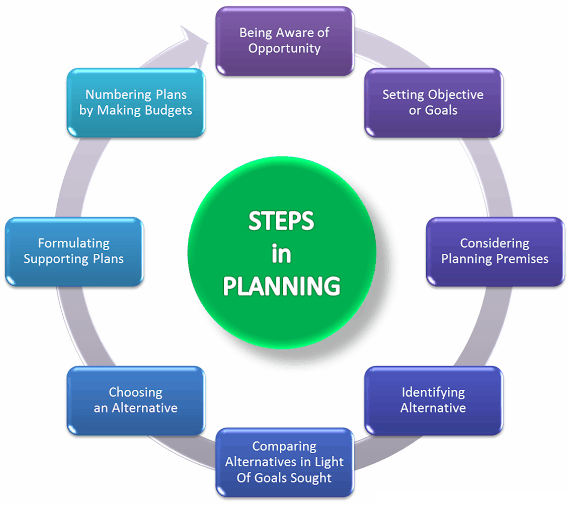Creating an Effective Plan involves a comprehensive and systematic cycle of 8 steps that must be maintained for establishing effective goals and plans for the organization’s employees.
To create an effective plan you need to enquirers about organizational strengths and weaknesses and involves decision making about desired ways and means to achieve them.
Usually, the same steps are followed by managers in all cases of planning. All of these steps taken serially result in a planning process.
An effective planning process appears future-oriented, comprehensive, systematic, integrated and negotiated. Minor plans are normally simpler and therefore, some of the steps can be easily taken.
8 Steps of Effective Planning Process are;
- Being aware of the opportunity
- Setting objectives or goals
- Considering planning premises
- Identifying alternative
- Comparing alternatives in light of goals sought
- Choosing an alternative
- Formulating supporting plans
- Numbering plans by making budgets
These steps are described below;

-
Being Aware of Opportunities
 Awareness of opportunities in the environment both external and internal in the organization is the real beginning point for planning.
Awareness of opportunities in the environment both external and internal in the organization is the real beginning point for planning.
At this stage, managers tend to create a foundation from which they will develop their plans for the next planning period.
This awareness stage is considered by some managers as a precursor to the actual planning process instead of taking it as an actual part of the process.
-
Establishing Objectives

Establishing specific objectives is the second step in planning. This involves determining goals or objectives for the enterprise as a whole and then for each subordinate tier and unit.
Awareness of opportunities in the context of strengths and weaknesses helps one establish a reasonable goal and draw up an action statement.
The establishment of objectives involves determining the same for the enterprise as a whole and each subordinate level or unit.
Many organizations, for example, consist of divisions, each of which is divided into departments which, in turn, may contain additional sub-systems such as committees and workgroups.
Managers are, therefore, required to develop an elaborate network of organizational plans to achieve the overall goals of their organization.
Comprehensive planning to be effective requires that managers in each sub-system of their organization; involved in the planning process.
Objectives that are going to guide the course of the organization in future years to come must be clear, concise and specific.
Objectives of enterprise act as a direction to the major plans, which, by reflecting these objectives define the objective of every major department.
Major department objectives, in turn, control the objectives of the subordinate department and so on down the line
In other words, objectives form a hierarchy.
-
Developing Premises

The third step in the logical sequence of planning is the establishment of the premises or assumptions on which action statements are built. The equality and success of any plan depending on the equality of the assumptions on which it is based. Even one wrong assumption can produce a poor or unrealistic decision.
These assumptions are, in fact, about the environment in which the plan is to be carried out. That all the managers involved in planning tend to agree on the premises is very important.
The major principle of planning premises is the more thoroughly individuals charged with planning understand and agree to utilize consistent planning premises the more coordinated enterprise planning will be.
Forecasting plays an important role in promising. Using forecasting, organizations try to answer various questions about future expectations and action statements.
Forecasting may be made on personal experience and expectation or systematic empirical research.
Managers base their forecasts in both cases on assumptions. “Premising” according to Dunham and Pierce,” therefore, involves forecasting what is likely to happen inside and outside an organization.
The forecasts go into the formulation of action statements to guide the organization in the future. There are two types of forecasts.
One type involves predicting the consequence of a planned course of action. This type helps managers understand what an organization might expect to achieve as a result of a planned course of action.
The second type of forecast helps managers to make predictions about environmental events likely to affect an organization’s movement towards achieving its objectives.
These forecasts are made to generate information for developing their action statements. Premising is based on this second kind of forecasting.
-
Determining Alternative Courses
 The fourth step is to search for and find out alternative courses of action, especially those not immediately apparent.
The fourth step is to search for and find out alternative courses of action, especially those not immediately apparent.
At this stage, managers decide how to move from their current position towards their decided future position.
There is hardly a plan for which reasonable alternatives are not available. It is also found quite often that an alternative not considered as obvious, proves to be the best.
Finding an alternative is not the problem normally. Reducing the number of alternatives to analyze and find out the best one is the problem.
There is a limit to the number of alternatives that can be examined thoroughly, even with mathematical techniques and computer.
At this, a manager usually draws upon research, experimentation, and experience to identify and develop several possible courses of action.
-
Evaluating Alternative Courses
 Once alternative courses of action have been identified after seeking out alternative courses and examining their strong and weak points, they must be evaluated in light of how well each would help the organization reach its goals.
Once alternative courses of action have been identified after seeking out alternative courses and examining their strong and weak points, they must be evaluated in light of how well each would help the organization reach its goals.
Evaluating alternatives also include determining the costs and expected effects of each.
One course may appear to be the most profitable but it may require a large cash involvement with a slow payback. Another course may look less profitable but that may be less risky.
Still, another course may better serve the long-range objectives of the company.
Evaluation can be difficult because of uncertainty about the future, various intangible factors and inaccurate premises behind plans. Several techniques can be used by managers at this step.
It is at this step in the planning process that operations research and mathematical as well as computing techniques can be primarily applied.
-
Selecting a Course
 After identifying the alternatives and considering the merits of each carefully, managers now shall have to adopt a plan and select one course of action.
After identifying the alternatives and considering the merits of each carefully, managers now shall have to adopt a plan and select one course of action.
A plan is adopted at this point and is, therefore, the real point of decision making. Two or more courses may appear to be advisable on occasional analyses and evaluation of alternative courses.
Managers may decide to follow several courses instead of one best course.
-
Formulating Derivative Plans
 Planning is not completed when a decision is made with the adoption of a general plan. Therefore, a seventh step is involved.
Planning is not completed when a decision is made with the adoption of a general plan. Therefore, a seventh step is involved.
Managers often still need to develop one or more supportive plans to bolster their basic plan and to explain the many details involved in reaching a broad major plan.
It is clear, therefore, that derivative plans are essentially required to support the basic or general plan. Usually, there are two kinds of derivative or supportive plans.
The first one involves changes in existing supportive plans. These are derivative plans that have been in use, but now need modification to support a new plan.
“The second kind of subsidiary plan involves the creation of a new support plan.
If, for example, an organization converted a plant from a traditional assembly line to one using a fully automated, computer-integrated manufacturing system, managers would need a new support plan for training employees to use the new equipment.
They would need another new supportive plan for maintaining the new equipment.
-
Numbering Plans by Budgeting
 When decisions are made and plans are set, the final step to give meaning to them is to quantify them with numbers converting them into budgets.
When decisions are made and plans are set, the final step to give meaning to them is to quantify them with numbers converting them into budgets.
Budgets are sometimes called enumerated programs that are most commonly expressed in terms of money. But they may also be expressed as hours worked, as units sold, or in any other measurable unit.
An enterprise usually has overall budgets representing the total of income and expenses, with .consequent profit or surplus.
Each department of the enterprise or organization can have its budgets, commonly of expenses and capital expenditures, which make up the overall budget.